The following is an article from Uncle John's 24-Karat Bathroom Reader.
Here's the strange story of a family-owned business so dysfunctional that business schools teach it as a lesson in how not to run a company.
FOOT SOLDIER
Not long after the end of World War I in 1918, an 18-year-old German soldier named Adolf Dassler returned to his hometown of Herzogenaurach, in northern Bavaria. Shoemaking was the biggest industry in the area, so it was no surprise when he decided to become a cobbler.
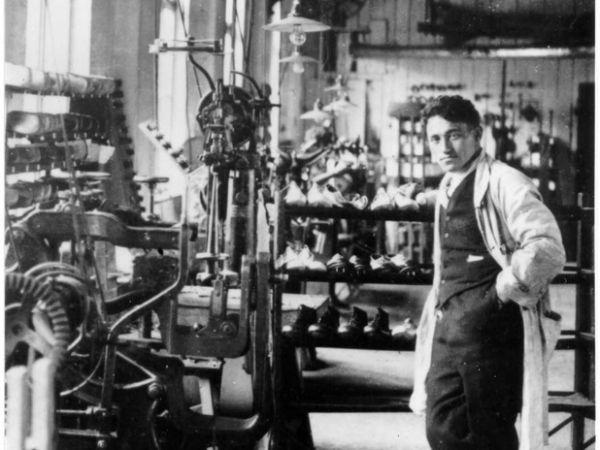
Dassler started small, working in an empty laundry shed behind his parents' house. There he constructed his first shoes -work shoes- out of leather scraps salvaged from wartime army helmets and other gear. His interest soon turned to athletic footwear. An inveterate tinkerer, he made his first sports shoes for his friends. But as his designs improved, his reputation spread beyond Herzogenourach, and he soon had more work than he could manage by himself.
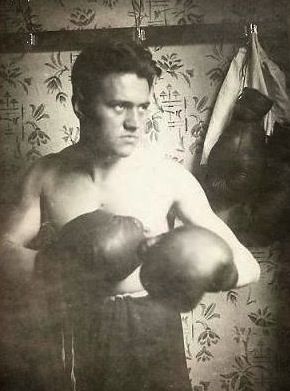 In 1923 his boisterous older brother Rudolf joined his business. "Rudi" handled sales while "Adi" made the shoes. In 1924 they formalized their partnership by founding the Dassler Brother Shoe Company. Two years after that, they moved their growing business into a factory on the other side of town.
In 1923 his boisterous older brother Rudolf joined his business. "Rudi" handled sales while "Adi" made the shoes. In 1924 they formalized their partnership by founding the Dassler Brother Shoe Company. Two years after that, they moved their growing business into a factory on the other side of town.
PARTY POOPERS
When Hitler seized power in 1933, Adi and Rudolf joined the Nazi Party. They certainly benefitted from Hitler's use of sports as a propaganda tool. But they weren't the most dedicated of party members, something that became clear during the 1936 Summer Olympics, held in Berlin. Hitler intended the Olympics to serve as a showcase for the Nazi doctrine of Aryan racial superiority, but all the Dasslers cared about was getting Jesse Owens, the famous?African-American track-and-field star, to wear Dassler Brothers shoes in the games. He did, and won four gold medals. Owens' victories gave the company its first international exposure. Soon athletes from all over Europe began making their way to tiny Herzogenaurach whenever they passed through Germany, to get a pair of Dassler Brothers shoes.
CAIN AND ADI
The brothers really had very little in common: Adi loved nothing more than to sit at his workbench and tinker with his shoes. Rudi, on the other hand, was a people person, but also short-tempered and loudmouthed. Their personalities complemented each other during the early years of the business. But as Germany moved closer to war in the late 1930s, their relationship became strained, made worse by the fact that they, their wives, their children, their parents, and all their siblings all lived together under the same roof in a villa in Herzogenaurach.
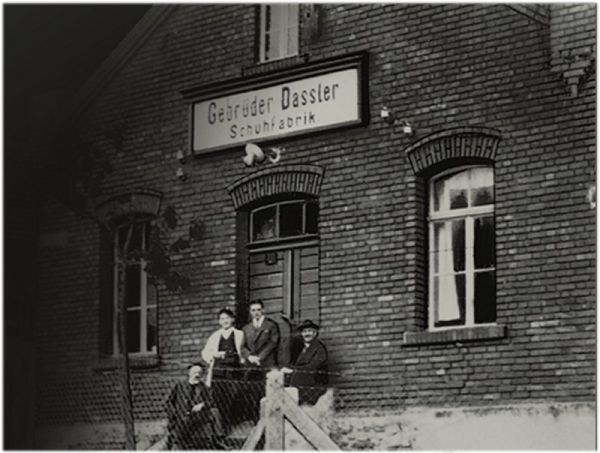
In December 1940, Adi was called up for military service, but he managed to get an exemption after just three months in uniform, perhaps with help from Rudi, who may have pulled strings from Herzogenaurach. If so, that probably made Rudi all the more bitter when?he was called up for military service in 1943 and couldn't get out of it. He was convinced that Adi and his wife Kathe had schemed to get him sent to the front so that Adi could have the business to himself. Rudi retaliated by trying to get the factory shut down so that Adi would also be sent to the front, but he failed.
OH BROTHER
In early 1945 Rudi deserted his post in Poland, fleeing just ahead of the advancing Russian army. He returned to Herzogenaurach, where a doctor friend declared him unfit for military service due to a frozen foot, but he was soon arrested by the Gestapo for desertion. He blamed that on Adi, too.? There may actually have been some truth to Rudi's belief that Adi was out to get him, because not long after Rudi was released by the Gestapo, he was arrested by the Allies, this time on suspicion of working?for the Gestapo.? According to the report filed by the American investigating officer, both Adi and K?the told investigators that Rudi had worked for the Gestapo. Result: Rudi spent a year in a POW camp. How did Adi spend the year? Rebuilding Dassler Brothers by selling athletic shoes to American GIs eager to buy the same kind of shoes that Jesse Owens had worn.
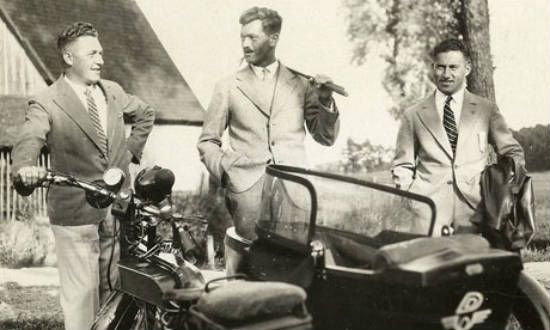 Rudy is on the left, Adi is on the right.
Rudy is on the left, Adi is on the right.
PAYBACK
Rudi retaliated in the summer of 1946, when Adi was hauled before the local denazification committee. Had Adi been classified as a?Belestater, or "profiteer," he could have lost control of Dassler Brothers -in which case Rudi might have been appointed to run the company -or he could have been stripped of ownership entirely.
Rudi appeared before the committee and did his best to paint Adi in a bad light, in the hope of assuming sole control Dassler Brothers.? And then he rejoined his wife and children under the same roof as Adi and his family. But not in the villa. That had been seized by American occupation forces, who would be living in it until further notice. For the time being, Rudi and his family, and Adi and his family, and their widowed mother, and their other siblings, would all squat together in makeshift accommodations in a Dassler Brothers shoe factory. All the while, the brothers battled each other in public for control of the company.
SPLITSVILLE
Adi beat the rap in November 1946, when the denazification committee classified him as a Mitlaufer, a "follower," or a Nazi who had not actively contributed to the party or profited from his association with it. He would not be barred from running Dassler Brothers.
But by that time neither of the brothers believed they could work together, and they decided to split the company in two. Rudi took the first step, moving his family and his mother (who sided with him) to new lodgings on the other side of the Aurach River, which runs through Herzogenaurach. He and Adi spent the next year and a half dividing the Dassler Brothers assets between themselves. Adi named his new company after himself, combining the first three letters of his first and last names to get?Adidas. Rudi took two letters from his first and last names to get "Ruda." Then he decided that Ruda sounded pudgy and un-athletic, so he changed his company's name to the more powerful-sounding Puma.
Neither brother may have realized it at the time, but the Dassler family feud was just getting started.
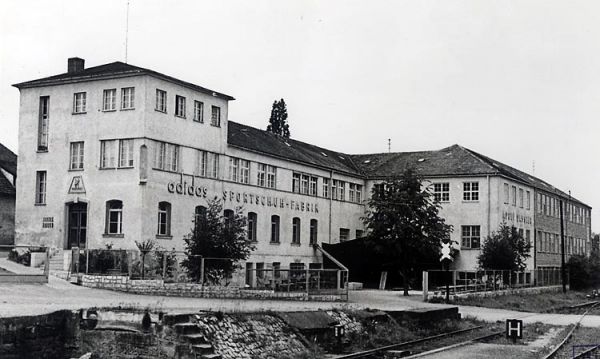
STRIPS AND STRIPES
Now that Adi and Rudi Dassler had split their shoe company into two new ones, both men wanted to be sure that customers would be able to tell Adidas and Puma shoes apart. It had been common practice for many shoemakers, the old Dassler Brothers company included, to sew vertical stripes of leather onto the sides of shoes to give them structure and strength. The strips weren't too noticeable, because they were the same color as the rest of the shoe.
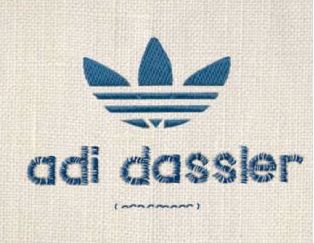 Adi Dassler decided that the strips -which were painted white or some other color to make them look like?stripes- would be the Adidas trademark. He made up sample shoes with two, three, four, five, and six stripes apiece, then asked his wife K?the and her sister Marianne to pick which ones they liked best. Two-stripe shoes were out: Some Dassler Brothers shoe designs had used two strips of leather, so Rudi would have grounds to fight a two-stripe trademark if he wanted to.
Adi Dassler decided that the strips -which were painted white or some other color to make them look like?stripes- would be the Adidas trademark. He made up sample shoes with two, three, four, five, and six stripes apiece, then asked his wife K?the and her sister Marianne to pick which ones they liked best. Two-stripe shoes were out: Some Dassler Brothers shoe designs had used two strips of leather, so Rudi would have grounds to fight a two-stripe trademark if he wanted to.
K?the and Marianne felt the shoes with four or more stripes looked too busy. They picked three stripes, and Adidas shoes have been made with them ever since. Over at Puma, Rudi played with a few designs, including a puma jumping through a capital "D," before eventually settling on the company's signature "formstripe," a horizontal stripe that begins at the back of the shoe, then widens as it move forward along the side of the shoe before turning town toward the sole.
SPLIT PERSONALITIES
When the Dassler brothers divided their company in two, the employees had to choose whether they wanted to work for Adi at Adidas or Rudi at Puma. Most of the technical people stayed with Adi; most of the sales force and administrators went with Rudi. That might seem like a formula for faster growth at Puma, since Rudi's people knew how to move the merchandise, but it wasn't. Adi's constant tinkering in the factory and also on the playing field, especially when the teams he supplied had really important games, proved the deciding factor. Adidas developed a reputation for superior designs that helped it grow into a major European brand. Puma was left to play catch-up. It grew, too, but at a slower pace, and remained primarily a national brand with strong ties to German soccer clubs.
THE TOWN OF BENT NECKS
As the years passed and Adidas and Puma loomed ever larger over the economy of tiny Herzogenaurach, the entire town was drawn into their feud. Nearly everyone worked at one company or the other (or was related to someone who did), so few people could avoid choosing a side. Dating, even socializing, across company lines was frowned upon. Marrying someone from the other side was out of the question. Herzogenaurach became known as "the town of bent necks," because people looked down to see which shoes people were wearing before engaging them in conversation.
Adidas people bought their bread from bakers who sided with Adidas, bought their meat from Adidas-friendly butchers and drank in Adidas-only beer halls. Puma workers did the same. Which bus a child took to school depended on whose side their parents were on, and so did the gang the kid joined. The rivalry that started soon after birth went all the way to the cemetery: Each side had its own tombstone carvers. And when Adi and Rudi died four years apart in the 1970s, they were buried in opposite corners of Herzogenaurach cemetery, as far apart as possible. They had carried their feud to the end of their lives, and the same was expected of everyone else.
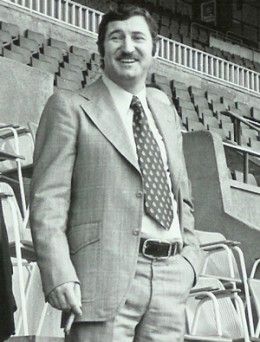 THE ENEMY IS US
THE ENEMY IS US
Had Adi and Rudi been able to patch up their differences in their lifetimes, and had their descendants not carried the feud into the next generation, the global athletic shoe business might look very different today. But they didn't. The brothers couldn't even limit themselves to fighting each other. Adi fought with his son and heir, Horst Dassler, finally banishing him to France, where Horst was put in charge of a shoe factory that was losing money. Horst turned it into a moneymaker, then built Adidas France into an operation that rivaled the rest of Adidas. But none of it was good enough for Adi. Writing from Herzogenaurach, Adi disowned his son in one angry letter after another.
Horst was so certain that Adi would throw him out of the company that he began diverting millions of Adidas dollars into his own sporting goods businesses, so that he'd have somewhere to go when he got tossed out. He concealed his activities behind shell companies and front men for several years. And though his scheming eventually was exposed, he never did get thrown out of Adidas. After Adi died in 1978, Horst battled his four sisters for control of Adidas, winning the fight in 1984 when his mother sided with him against his sisters.
THE CUB
Over at Puma, Rudi's relationship with Armin Dassler, his oldest son and heir, was no better. Rudi routinely belittled him in front of other company executives, and Armin chafed at his father's overbearing nature and outmoded ways of doing business. Armin could see what his cousin Horst was accomplishing at Adidas, and it drove him crazy that he couldn't do the same at Puma. Armin finally banished?himself to Salzburg, Austria, to run a Puma factory there. When the Austrian athletic shoe market proved less profitable than expected, Armin started selling shoes to the U.S. market, something Rudi had expressly forbidden. Armin actually had to go behind Rudi's back to introduce his father's shoes to the largest sporting goods market in the world.
The relationship between father and son never did improve. When Rudi died in 1974, Armin was stunned to learn that Rudi had written him out of the will. Only a legal technicality allowed Armin to inherit a controlling 60 percent interest in Puma against his father's dying wishes. Armin's younger brother Gerd inherited the other 40 percent.
THE LIGHT STUFF
The constant battles between Adidas and Puma, and the battles within both companies, distracted them from a larger threat by a onetime University of Oregon track-and-field coach named Bill Bowerman and his former athlete Phil Knight.
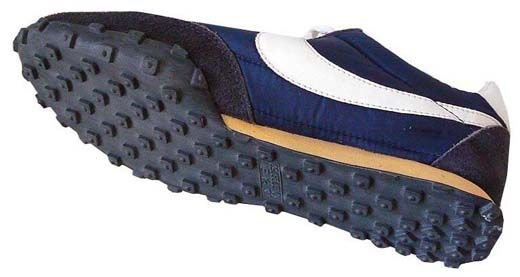 Bowerman was a lot like Adi Dassler: He liked to tinker with shoe designs. He thought ordinary athletic shoes, like the ones made by Adidas and Puma, were too heavy. He believed that if shoes were lighter, his athletes would be able to run faster. So in the early 1970s he invented a shoe he called the Waffle (so named because he made the shoe's revolutionary urethane sole in his wife's waffle iron).
Bowerman was a lot like Adi Dassler: He liked to tinker with shoe designs. He thought ordinary athletic shoes, like the ones made by Adidas and Puma, were too heavy. He believed that if shoes were lighter, his athletes would be able to run faster. So in the early 1970s he invented a shoe he called the Waffle (so named because he made the shoe's revolutionary urethane sole in his wife's waffle iron).
Phil Knight's company, Blue Ribbon Sports, imported Tiger brand athletic shoes from Japan. But he wanted his own line of shoes, and he thought Bowerman's Waffle design had promise. He arranged for some of his Japanese suppliers to manufacture Waffles in their factories. Knight considered naming the new brand Dimension Six, but an employee suggested naming it after the winged goddess of victory in Greek mythology, Nike. That sounded better. In time Knight would rename the entire company Nike ?but only after he'd paid a graphic design student named Carolyn Davidson $35 to come up with a logo -the Nike "Swoosh."
MEANWHILE, BACK IN GERMANY
Nike Waffles hit the market in 1974, the same year that Armin Dassler took the helm at Puma. It wasn't long before some Waffles found their way to Herzogenaurach, along with warnings from alarmed Puma and Adidas distributors in America that Nikes were a serious problem that needed to be dealt with immediately.
Neither Horst Dassler at Adidas nor his cousin Armin at Puma saw the Waffle as much of a threat. It went against everything the companies understood about good athletic shoe design: They were too light, weighing little more than bedroom slippers; they were too flimsy; and the soles were made in a waffle iron. Both Horst and Armin gave Nikes a quick once-over, had a good laugh, and went back to fighting each other.
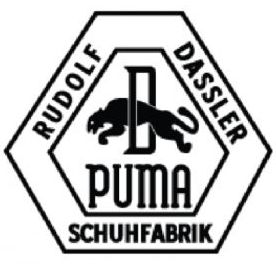 LOSING GROUND
LOSING GROUND
Puma was the first company to feel the full impact of Nike's rise. Armin waited five years before responding to the threat and then, in 1979, he replaced his U.S. distributor in an attempt to boost the company's flagging American sales. When that failed he spent millions of dollars buying out the new distributors. That didn't work either, and when he tried to sell Pumas through mass-market discounters like Kmart, all it did was tarnish Puma's image, which got even worse when Foot Locker and other athletic shoe retailers retaliated by dumping the brand.
In 1986 Armin took Puma public, hoping that listing shares on the Frankfurt stock exchange would bring in money from outside investors. But as soon as outsiders realized how much money Puma was losing, thanks to crashing sales in the U.S., the company's stock price collapsed. In September 1987, Deutsche Bank seized control of the company to prevent it from going under. Then it fired Armin Dassler and his sons Frank and Jorg. Puma was a Dassler company no more.
DOUBLE TROUBLE
By the time Adidas finally came up with a lightweight running shoe to compete against the Waffle in the late 1970s, Nike dominated the market. When Nike introduced the Air Jordan basketball shoe in 1985, it pushed Adidas off American basketball courts as well, racking up $100 million in Air Jordan sales the first year alone.
When Reebok, a British shoe company with just $300,000 in sales in 1980, introduced a shoe designed specifically for the aerobics craze, Adidas declined to offer a competing product, because aerobics was not a "sport." By 1987 Reebok had grown into a $1.4 billion-a-year business. Two years later it was the largest athletic shoe company in the world.
AUF WIEDERSEHEN
Horst Dassler didn't live to see Adidas' day of reckoning; he died of cancer in 1987 at age 51. His death sparked another family battle for control of the company, this time between his two children (Adi, Jr. and Suzanne), who owned 20 percent of Adidas shares, and his four sisters, who controlled the other 80 percent.
Through 1988 Adidas was still the largest sporting goods company in the world, just slightly ahead of Reebok and Nike. But by the end of 1989 it had fallen behind both companies and even behind the Converse shoe company, and sales continued to fall. A plunge from first place to fourth in one year was more than Horst Dassler's sisters could stomach. Mindful of what happened to their cousins over at Puma, they decided to unload Adidas while they still had something to sell. On July 4, 1990, they sold their shares to a French industrialist for $273 million. By then Adi Jr. and his sister Suzanne had already sold most of their shares to pay their inheritance taxes. The Dassler era was over.
LIFE AFTER DASSLERS
Reebok's reign at the top did not last. By the late 1990s, it had slipped to a distant third behind Nike and Adidas, and it never caught up again. In 2005 it was acquired by Adidas, but as of 2011 Nike was still larger than its two rivals combined. In 2007 Puma was acquired by the French conglomerate Pinault-Printemps-Redoute (PPR), which also owns Gucci, the Italian luxury-goods label.
Both Adidas and Puma are still headquartered in Herzogenaurach, though shoes are no longer made in the village. Now that the factory jobs are gone, the rivalry that divided the town for decades has largely disappeared. Today Rudi's grandson Frank Dassler, fired from Puma in 1987, works for Adidas.
About the only time the rivalry resurfaces is when tradespeople hired to work in the Adidas or Puma headquarters show up wearing the wrong kind of shoes. That's a tradition that dates back more than 60 years, when laborers deliberately wore the wrong shoes when working in Adi or Rudi's homes -they knew that if Adi saw Pumas in his house or Rudi saw Adidas in his, they'd give workers a free pair of the right kind of shoes. "Rudolf simply could not stand the fact that someone was wearing an Adidas shoe in his private home," Frank Dassler says.
___________________
 The article above was reprinted with permission from the newest volume of the Bathroom reader series, Uncle John's 24-Karat Bathroom Reader.
The article above was reprinted with permission from the newest volume of the Bathroom reader series, Uncle John's 24-Karat Bathroom Reader.
Since 1988, the Bathroom Reader Institute had published a series of popular books containing irresistible bits of trivia and obscure yet fascinating facts. If you like Neatorama, you'll love the Bathroom Reader Institute's books - go ahead and check 'em out! 
Source: http://www.neatorama.com/2012/11/19/Family-Feud-Adidas-vs-Puma/
what time does the superbowl start kobayashi margaret sanger paul george eddie long ufc 143 weigh ins micron ceo


 In 1923 his boisterous older brother Rudolf joined his business. "Rudi" handled sales while "Adi" made the shoes. In 1924 they formalized their partnership by founding the Dassler Brother Shoe Company. Two years after that, they moved their growing business into a factory on the other side of town.
In 1923 his boisterous older brother Rudolf joined his business. "Rudi" handled sales while "Adi" made the shoes. In 1924 they formalized their partnership by founding the Dassler Brother Shoe Company. Two years after that, they moved their growing business into a factory on the other side of town.
 Rudy is on the left, Adi is on the right.
Rudy is on the left, Adi is on the right.
 Adi Dassler decided that the strips -which were painted white or some other color to make them look like?stripes- would be the Adidas trademark. He made up sample shoes with two, three, four, five, and six stripes apiece, then asked his wife K?the and her sister Marianne to pick which ones they liked best. Two-stripe shoes were out: Some Dassler Brothers shoe designs had used two strips of leather, so Rudi would have grounds to fight a two-stripe trademark if he wanted to.
Adi Dassler decided that the strips -which were painted white or some other color to make them look like?stripes- would be the Adidas trademark. He made up sample shoes with two, three, four, five, and six stripes apiece, then asked his wife K?the and her sister Marianne to pick which ones they liked best. Two-stripe shoes were out: Some Dassler Brothers shoe designs had used two strips of leather, so Rudi would have grounds to fight a two-stripe trademark if he wanted to. THE ENEMY IS US
THE ENEMY IS US Bowerman was a lot like Adi Dassler: He liked to tinker with shoe designs. He thought ordinary athletic shoes, like the ones made by Adidas and Puma, were too heavy. He believed that if shoes were lighter, his athletes would be able to run faster. So in the early 1970s he invented a shoe he called the Waffle (so named because he made the shoe's revolutionary urethane sole in his wife's waffle iron).
Bowerman was a lot like Adi Dassler: He liked to tinker with shoe designs. He thought ordinary athletic shoes, like the ones made by Adidas and Puma, were too heavy. He believed that if shoes were lighter, his athletes would be able to run faster. So in the early 1970s he invented a shoe he called the Waffle (so named because he made the shoe's revolutionary urethane sole in his wife's waffle iron). LOSING GROUND
LOSING GROUND The article above was reprinted with permission from the newest volume of the Bathroom reader series, Uncle John's 24-Karat Bathroom Reader.
The article above was reprinted with permission from the newest volume of the Bathroom reader series, Uncle John's 24-Karat Bathroom Reader.


